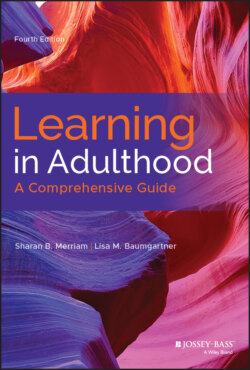Читать книгу Learning in Adulthood - Sharan B. Merriam - Страница 36
Indigenous Learning/Indigenous Knowledge
ОглавлениеIndigenous learning is learning linked with a culture. It refers to processes and structures people in particular societies have used to learn about their culture throughout their history (Graveline, 2005). As Morrison and Vaioleti (2017) write:
Over generations, indigenous peoples across the world have built up layers and layers of complex history and knowledge that connects them with their environment, their spiritual world, and their ancestors and allows them to live sustainably and wisely for the well-being of their collectives (p. 47).
Conscious use of indigenous forms of learning, which are often steeped in oral traditions and art forms, can enhance nonformal and perhaps even formal educational programs. Storytelling, for example, is often used by African American women to teach about the joys and sorrows of life. When teaching these women, instructors could incorporate storytelling as an important method of learning about the topic at hand, from surviving in modern-day organizations to basic literacy skills. In another example, Hicks and Rowel (2004) studied the nonformal indigenous learning of six public housing community leaders who were inspirational in helping others in their community. These women were effective by modeling exemplary leadership, practicing what they preached, and communicating with diverse groups.
Descriptions of indigenous forms of learning can be found in both scholarly and more popular literature (see Chapter 10). Cajete (1994) eloquently describes the tribal foundations of American Indian education, which he sees as “shared by Indigenous cultures of the world” (p. 33). In tracing these foundations, Cajete observes:
We are tracking the earliest sources of human teaching and learning. These foundations teach us that learning is a subjective experience tied to a place environmentally, socially, and spiritually. Tribal teaching and learning were intertwined with the daily lives of both teacher and learner. Tribal education was a natural outcome of living in close communion with each other and the natural environment. The living place, the learner's extended family, the clan and tribe provided the context and source for teaching… . Informality characterized the greater part of American Indian teaching and learning… . However, formal learning was usually required in the transfer of sacred knowledge.
Hahoh is a Tewa word sometimes used to connote the process of learning. Its closest English translation is to “breathe in.” Hahoh is a sacred metaphor describing the perception of traditional Tribal teaching—a process of breathing in—that was creatively and ingeniously applied by all tribes… . Through these methods [such as storytelling, dreaming, tutoring, and artistic creation], the integration of inner and outer realities of learners and teachers were fully honored, and the complementary educational processes of both realities were fully engaged (Cajete, 1994, pp. 33–34).
Cajete beautifully expresses what teaching and learning mean to him:
A parable that often flashes through my memory during times of quiet, deep relaxation, or just before I fall asleep: ‘It is an essential, life-sharing act of each generation of a People to nurture that which has given them Life and to preserve for future generations the guiding stories of their collective journey to find life’ (1994, p. 187).
According to Cajete, “among American Indians, education has always included a visionary expression of life. Education has been, and continues to be, a grand story, a search for meaning, and an essential food for the soul” (2010, p. 1131). Cajete's recognition of the importance of the “natural environment” in indigenous knowledge systems is reflected in recent research on the link between indigenous communities and the environment. For example, Hendry's (2014) book explores indigenous wisdom with regard to science and sustainability. Lowen-Trudeau (2017) studied teaching and learning in indigenous environmental movements, and Bardsley and Wiseman (2016) reported on indigenous community-based monitoring of environmental change in Australian rangelands. And in a discussion of the term indigenous, Morrison and Vaioleti (2017) concur: “What seems to be the defining quality and foremost in the thinking by indigenous people is their tie to land” (p. 48).
Brennan (1997, p. 191) has observed that “the lack of attention to the indigenous learning structure may have been initially the work of missionaries who viewed indigenous culture as inferior and non-Christian and therefore to be ignored or if necessary repressed.” He goes on to suggest a four-stage process for recognizing indigenous learning as an essential part of the nonformal system of learning for adults. In Stage 1, approaches or techniques that may be relevant to educational or developmental activities are identified—for example, the role of traditional dance and music and the use of legends, myths, tales, and proverbs. Stage 2 involves classifying these approaches and techniques into a system that educators in more formal settings can understand and integrate into their own ways of thinking. “The third stage,” he writes, “is associated with advocacy for the exploration of a broader indigenous learning ‘system’ … [and] the fourth stage is represented by the development of more detailed and comprehensive learning ‘systems’ for a particular cultural group” (pp. 192–193). Indigenous forms of learning can also be seen as informal or self-directed learning, as was described by Cajete and is examined in the next section.
